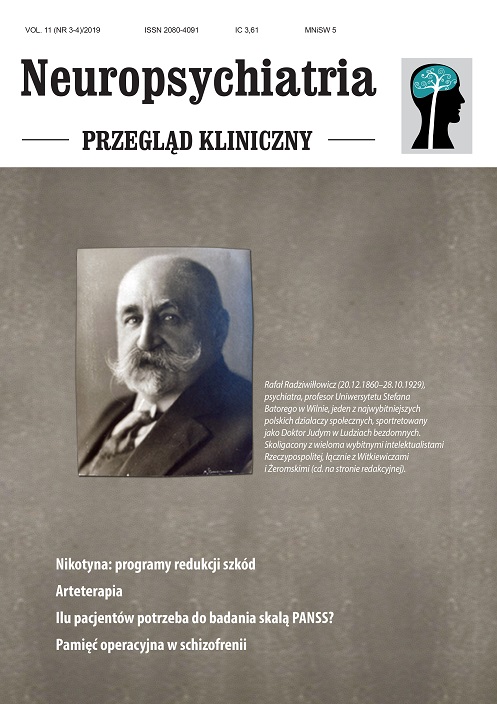PANSS: how many patients should we include for research Review article
Main Article Content
Abstract
Positive and Negative Syndrome Scale (PANSS) is one of the basic research tools in schizophrenia and other mental disorders. The impact of group size on the results of factor analyzes in paranoid schizophrenia, and thus on the reliability and validity of the test results, was analyzed. To do this, the group of 400 patients was examined, including to factor analysis gradually decreasing number of 400, 350, 300, 250, 200, 150, 100, 75 and 50 patients. Factor analysis of 100 or smaller groups turned out to be unstable, while satisfactory stabilization of results was obtained when analyzing 150 or more patients.
Article Details

This work is licensed under a Creative Commons Attribution-NonCommercial-NoDerivatives 4.0 International License.
Copyright: © Medical Education sp. z o.o. License allowing third parties to copy and redistribute the material in any medium or format and to remix, transform, and build upon the material, provided the original work is properly cited and states its license.
Address reprint requests to: Medical Education, Marcin Kuźma (marcin.kuzma@mededu.pl)
References
2. DSM-5. American Psychiatric Association. Washington 1993.
3. Perkins G, Wyatt RJ, Bartko JJ. Penny-wise and pound-foolish: the impact of measurement error on sample size requirements in clinical trials. Biol Psychiatry 2000; 47: 762-766.
4. Coovert MD, McNelis MR. Determing the number of common factors in factor analysis: a review and program. Educational Psychological Medicine 1988; 48: 687-692.
5. Gorsuch RL. Factor analysis. Philadelphia, PA, Saunders 1974.
6. Andreasen N, Arndt S, Alliger R et al. Symptoms of schizophrenia. Arch Gen Psychiatry 1995; 52: 341-351.
7. WHO, World Health Organisation. The ICD-10 Classification of Mental and Behavioural Disorders – Diagnostic Criteria for Research. Geneva 1992.
8. Lindenmayer JP. Are Shorter Versions of the Positive and Negative Syndrome Scale (PANSS) Doable? A Critical Review. Innov Clin Neurosci 2017; 14(11-12): 73-76.
9. Łoza B. Czynnikowa struktura zaburzeń schizofrenicznych – część 1: teoria. Postępy Psychiatrii i Neurologii 1999; 8: 181-191.
10. Łoza B. Czynnikowa struktura zaburzeń schizofrenicznych – część 2: badania za pomocą skal KOSS i PANSS. Postępy Psychiatrii i Neurologii 1999; 8: 193-204.
11. Loza B, Kucharska-Pietura K, Kopacz G, Debowska G. Factor structure of paranoid schizophrenia: a prospective study. Psychopathology 2003; 36(3): 132-141.

